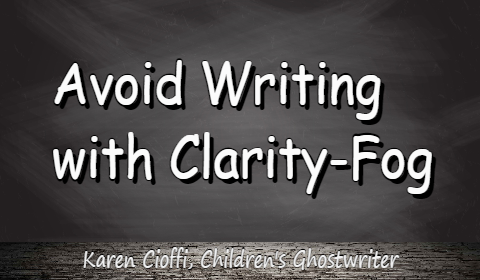Writing with clarity is a common challenge that many writers face. There isn’t a GPS for clarity. And no matter how clearly you think you are conveying a particular sentence, paragraph, or theme, you may not be able to see that you’ve missed the clarity mark.
How does this happen?
Missing the clarity mark may happen even if your thoughts are crystal clear.
If those crystal-clear thoughts or intent don’t translate onto paper, you’ve missed the mark.
As the author of the piece, you know what you’re thinking, what motives are involved and what you assume the reader should see or understand.
It’s this very knowledge or assumptions that may cloud your perception of what you are actually conveying. This clarity cloud can create a gap between what you think you’re saying and what you have on the page. This thought-to-paper miscommunication happens because you’re too close to your own writing.
Think of a color. Now, think of a very specific hue or shade within that color. Now, try to write what you see or explain it.
You can see it. You write what you see and are sure the reader will get it.
But will the reader get it?
This is what can happen with your story. You can see what’s unfolding clear as day: the scene, the characters… the intent. But, your vision may not translate with clarity onto paper. You may think it has. You can see it perfectly, but that doesn’t mean it has actually translated onto the paper.
An example of this is a children’s picture book I reviewed. The content and illustrations were well done, but there was one BIG problem. Ultimately, the story was about the main character having to go through a metamorphosis in order to be accepted by others.
This need to change in order to be accepted is what a reader, a child, could very well take away from the story.
While the story had a number of good points, this one flaw was a biggie. The authors knew what they intended, which was probably a story of the MC striving and struggling to be accepted and finally succeeding. But that intent wasn’t what I saw as the reader.
This is not to say that every reader would see what I saw, but do you want to take that chance, especially if you’re writing for children?
Fortunately, there is help in this area: a critique group.
Every writer who is writing a manuscript should belong to a critique group. Having three, six, or ten other writers, who write in the same genre, will help you find many of the pitfalls in your story.
The critique group is the unknowing audience. They have no perceived conception of your story or knowledge of your intent, so they will be able to see where it goes astray and where it lacks clarity.
Other avenues of help: ask your local librarian, or a teacher to read it. You might even enlist a family member to read it, but be a bit cautious with this one. You can also get a professional critique or review of your story.

Writing Rhyme in Children’s Stories
The Writing Elements Mix – Is There a Right Balance?
Getting to Know Your Characters

I’m a working children’s ghostwriter, rewriter, editor, and coach. I can help turn your story into a book you’ll be proud to be the author of, one that’s publishable and marketable.
OTHER HELP I OFFER:
HOW TO WRITE A CHILDREN'S FICTION BOOK
A DIY book to help you write your own children’s book.
PICTURE BOOK, CHAPTER BOOK, MIDDLE GRADE COACHING
Four to twelve-week coaching programs.
WRITERS ON THE MOVE SELF-PUBLISHING SERVICE
Self-publishing help for children’s authors.
You can contact me at: kcioffiventrice@gmail.com. Or give me a call at 347—834—6700. (Please leave a message- I’ll get back to you as soon as I can.)


6 thoughts on “Writing with Clarity”